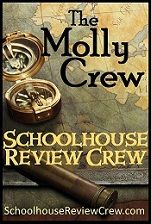Homeschool Legacy's Once-a-Week Unit Studies are Biblically based, Science and History units for grades 2 - 12 created by fellow homeschooling Mom, Sharon Gibson. As stated on their website: Our goal is to help you instill a love of learning in your children and to help you get them fired up for the Lord. The studies are designed to be used one day a week either as a supplement to your curriculum or as a stand alone unit that covers all areas of study. Probably one of the coolest features of the unit studies (other than the "Stump Dad Trivia" questions that are added at the end of each section) is there are activities and ideas included so Boy Scouts and American Hertitage Girls can earn merit badges. If you have kids involved in those groups, that is a very awesome feature. I know Julianna was all about earning petals when she was a Daisy Scout...unfortunately that was solely at the discretion of her troop leader. They didn't get many petals that year. :-(
Sorry, I digress. To go along with our history, we chose the Early Settlers in America title to review. This unit study was organized into six comprehensive weekly lessons covering the "lost colony" - Roanoke, NC, Jamestown, Holland, Plymouth, Pennsylvania and NY, as well as giving tips on how to schedule your week and the information needed for earning badges.
My musings:
We enjoyed going through this unit study. It worked better for us to split the lessons up into smaller parts to supplement our history rather than complete each weekly section in a day. Plus, we could introduce some of the colonies that we won't be learning about until a little later on throughout the year. Each lesson comes with suggested readings and activities to do, so some pre-planning (to make sure you have all the materials available) and a trip to the library is probably required to get the books. I wasn't able to find some of the titles listed, so I substituted books I already had or found ones from on the same subjects at the library. We're flexible. Some of the activities listed we had already done recently either while on vacation (writing with quills at Monticello) or on a recent field trip to a local historical park (making ink and writing (again) with quills), but we did enjoy making a Bilbo Catcher toy (Anytime I hear the name of this toy I can't help but think of Bilbo Baggins from The Hobbit. Lol It's actually from Bilboa, Spain.) We'd played with a wooden one before, so we were familiar with how it works.
Here are a few pictures:
Early Settlers in America is only one of eleven different once-a-week unit study titles available. It is available for purchase from the Homeschool Legacy website for $17.95. Check them out. :-)

* Disclaimer: As a member of the TOS Homeschool Crew, I received a copy of the Early Settlers unit study in exchange for my honest review. No other compensation was given. *









